Key takeaways:
- Community storytelling fosters connections, empathy, and a sense of belonging by sharing individual experiences and vulnerabilities.
- Sharing personal narratives can bridge generational gaps, highlight common struggles, and cultivate a supportive environment.
- Storytelling encourages inclusion by creating spaces for diverse voices, empowering individuals to acknowledge their own challenges while fostering community action.
- Support groups provide a platform for collective healing and resilience, transforming isolation into empowerment through the sharing of experiences.
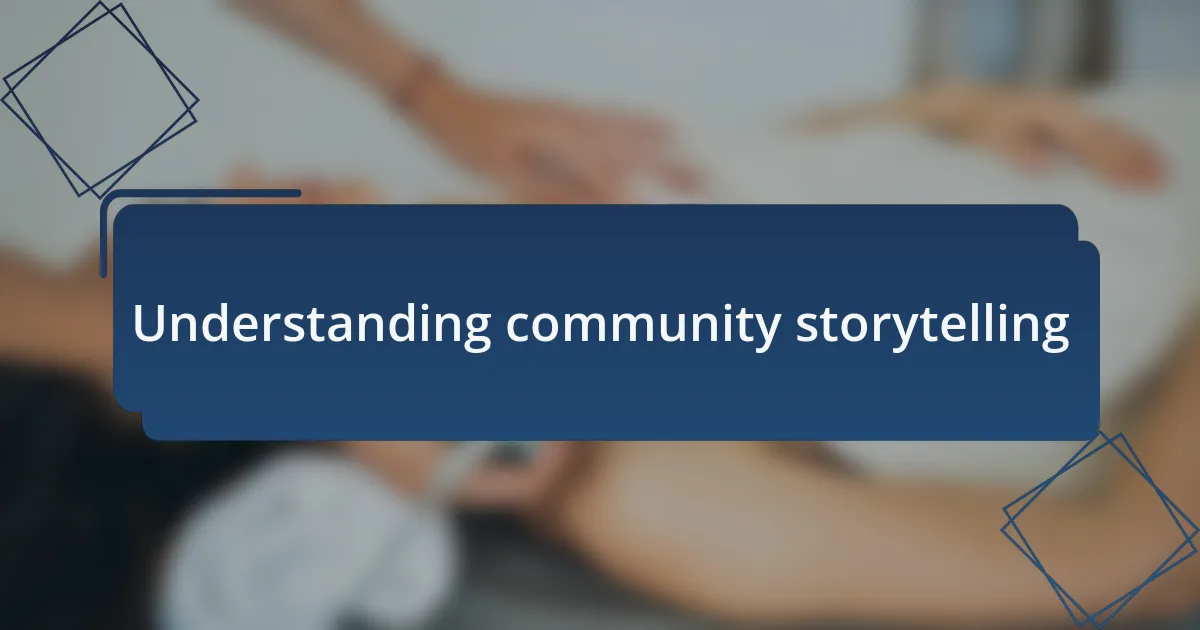
Understanding community storytelling
Community storytelling is a powerful tool that allows individuals to share their experiences and connect on a deeper level. I remember attending a local storytelling event where people shared their journeys living with cerebral palsy. Each story, filled with unique challenges and triumphs, created a sense of belonging that was palpable.
One striking moment for me was when a young woman described how she overcame social isolation through her love for art. Listening to her, I couldn’t help but feel a swell of admiration. Isn’t it incredible how shared narratives can inspire us to see the strength in our vulnerabilities and find our own paths forward?
Engaging in community storytelling fosters empathy and understanding among participants. Have you ever felt like your story could help someone else? I certainly have, and I’ve learned that when we share openly, we not only validate our experiences but also invite others to do the same, creating a collective sense of resilience.
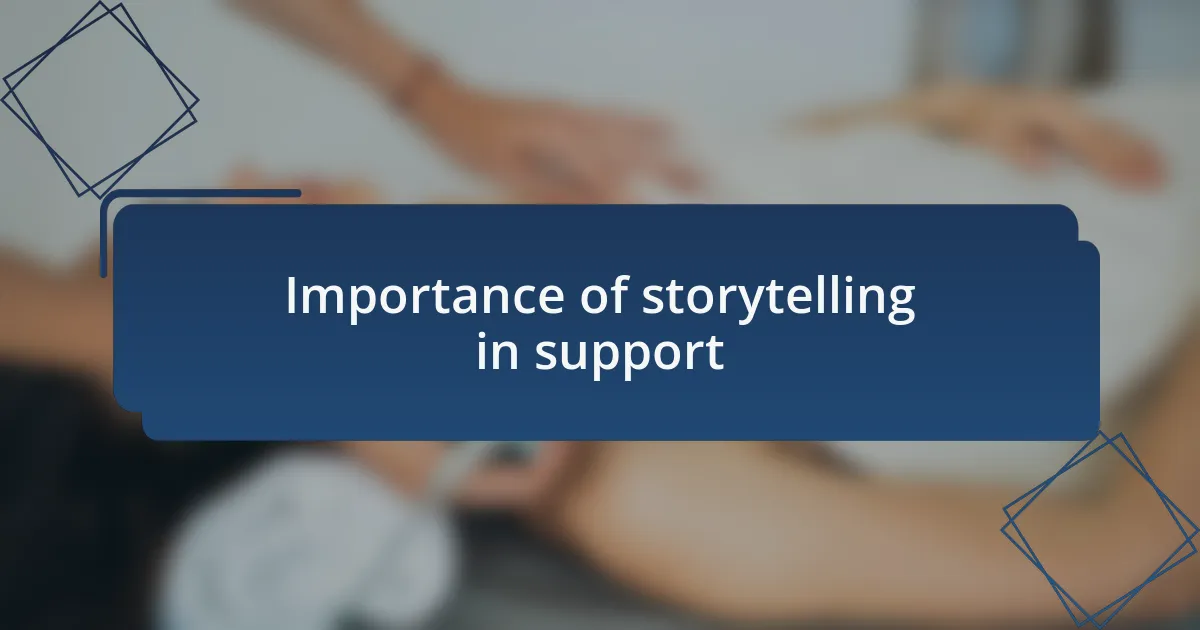
Importance of storytelling in support
Storytelling is a vital component of support because it provides a safe space for individuals to express their feelings and experiences. I vividly recall a moment at a community gathering when an elderly gentleman shared his childhood struggles with cerebral palsy. His voice trembled as he spoke, and the room fell silent; in that moment, I realized that vulnerability could bridge gaps between generations, fostering a sense of connection and understanding that transcends time.
In sharing our stories, we highlight commonalities that might otherwise remain hidden. I once participated in a small group where each person detailed their personal challenges. As we listened, I felt a powerful realization wash over me—everyone has faced obstacles, yet the ways we navigate them can be so different. This oral exchange not only encouraged me to be more open but also prompted others to reflect on their journeys, nurturing a supportive environment rich in empathy.
Moreover, storytelling can serve as a reminder that we’re not alone in our struggles. I remember reading a heartfelt narrative from a fellow advocate who detailed her experience with discrimination because of her disability. I was moved by her courage and found myself contemplating my own experiences in light of hers. How many of us feel isolated in our challenges? Cultural narratives like hers remind us that, through openness, we can cultivate a community built on shared understanding and strength.
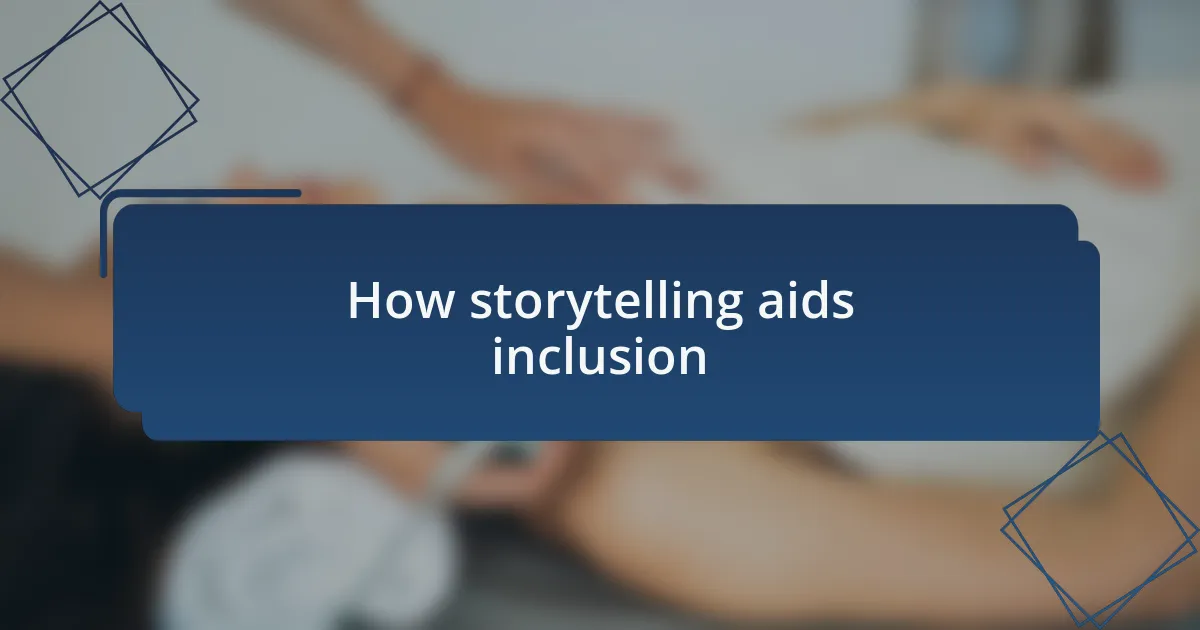
How storytelling aids inclusion
Storytelling plays a crucial role in fostering inclusion by creating a space where diverse voices can be heard. I recall a workshop I attended where participants from various backgrounds shared their experiences with accessibility challenges. As each story unfolded, I noticed how individuals began nodding in recognition, feeling the weight of shared experiences. Isn’t it fascinating how hearing someone else’s tale can empower us to acknowledge our own struggles?
When I think about the power of storytelling, I remember a woman who spoke about her journey as a caregiver for her son with cerebral palsy. She described her feelings of isolation and frustration but also the moments of triumph that made her journey fulfilling. Listening to her, I couldn’t help but reflect on my own highs and lows while supporting my friend. These narratives did more than just resonate; they built a tapestry of connection that included everyone in the room, demonstrating how mutual understanding can transcend barriers created by disability.
Moreover, stories often highlight the importance of community action. I once joined a neighborhood meeting where residents shared their encounters with local accessibility issues. Each story added weight to the conversation and rallied everyone to brainstorm solutions collectively. Why does it often take our personal narratives to spark change? By sharing our unique stories, we not only foster inclusion but also encourage active participation, transforming individual challenges into collective action for progress.
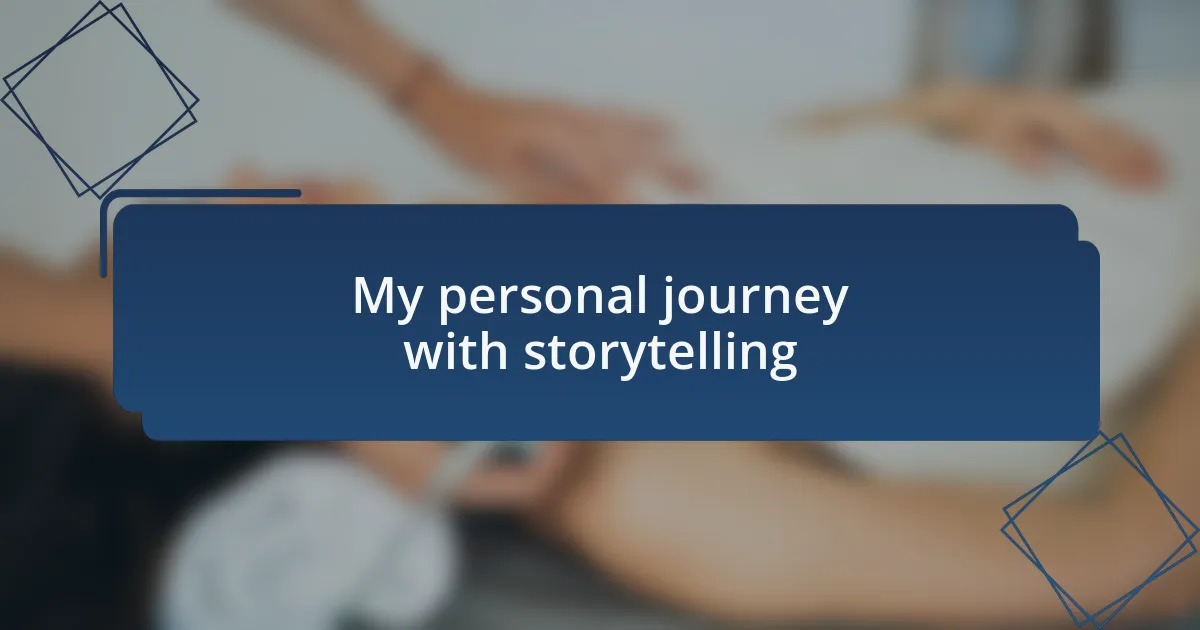
My personal journey with storytelling
Reflecting on my own journey with storytelling, I remember how I first stumbled upon its transformative power during a local support group meeting. I was nervous, hesitant to share my experiences with cerebral palsy, thinking they might bore or overwhelm others. However, when I finally opened up about my challenges and victories, I discovered an unexpected warmth filling the room. It was as if my words created a bridge connecting my experience with those of others, which ultimately sparked deeper conversations.
One story stands out in particular. I shared my feelings of frustration after a particularly difficult day, and as I spoke, I noticed several nods of understanding. Later, a fellow participant approached me, sharing how my story encouraged her to voice her own struggles. It struck me then that storytelling is not just about sharing; it’s about resonating. Isn’t it incredible how a simple exchange of experiences can foster a supportive community?
Through these moments, I’ve come to view storytelling as a beacon of inclusion. I recall a time spent with my friends at a community event where we swapped anecdotes about facing accessibility challenges. The laughter, tears, and unspoken understanding revealed just how crucial it is to share our journeys. When did storytelling become more than just a pastime for me? It became a lifeline, a way to connect and heal, reminding me that every narrative carries the potential to unite and uplift.
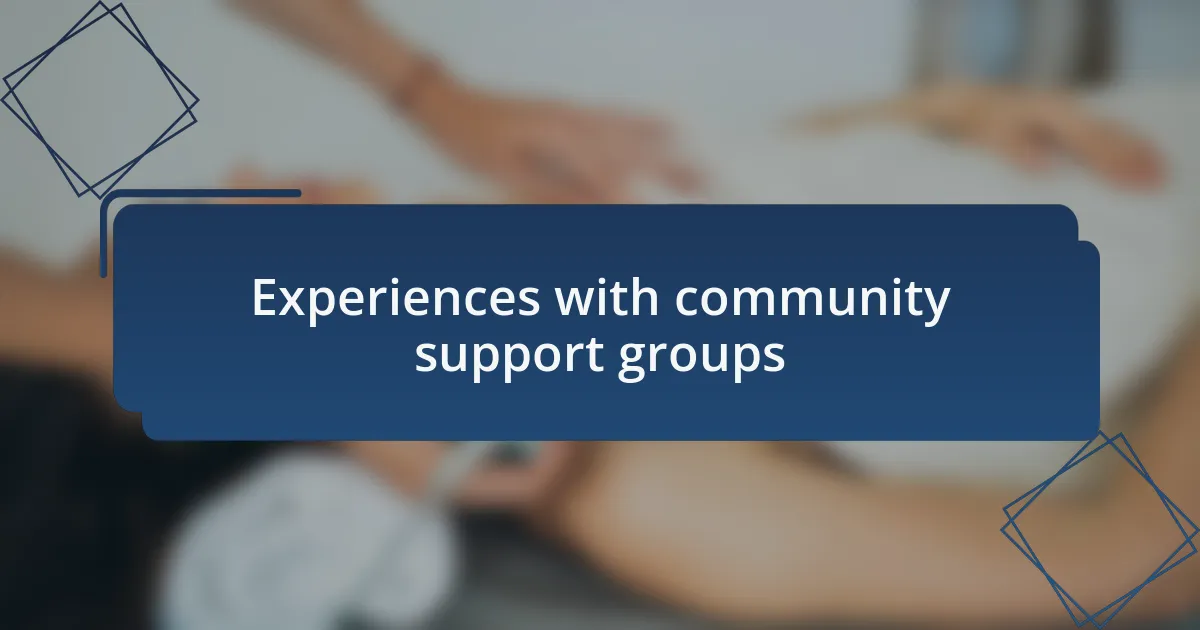
Experiences with community support groups
Attending community support groups has been a pivotal part of my journey, often feeling like stepping into a safe haven. I remember sitting in a circle, sharing my experience with a recent therapy session and the struggles that came with it. The empathetic eyes around me reminded me that I wasn’t alone in this. Have you ever felt that moment when you realize others understand your pain? It’s a profound experience that solidifies the bond within the group.
On another occasion, I participated in a workshop focused on self-advocacy, where individuals openly discussed their triumphs and setbacks. I was moved by one participant’s story, where she openly spoke about her frustration with healthcare access. Hearing her articulate those feelings made me think about my own challenges, and I couldn’t help but question—what if we all spoke out more? That day, we created a shared commitment to support one another, inspiring me to advocate for our collective voice.
Over time, I have learned that these gatherings are more than just meetings; they are a lifeline for many. Once, during a particularly emotional session, we crafted a group story, allowing each member to contribute a piece of their journey. I was amazed by how this collective effort brought raw emotions to the surface while fostering a sense of solidarity. With each narrative, I felt the weight of isolation lift, replaced by the strength of community. Isn’t it fascinating how shared stories can transform pain into empowerment?
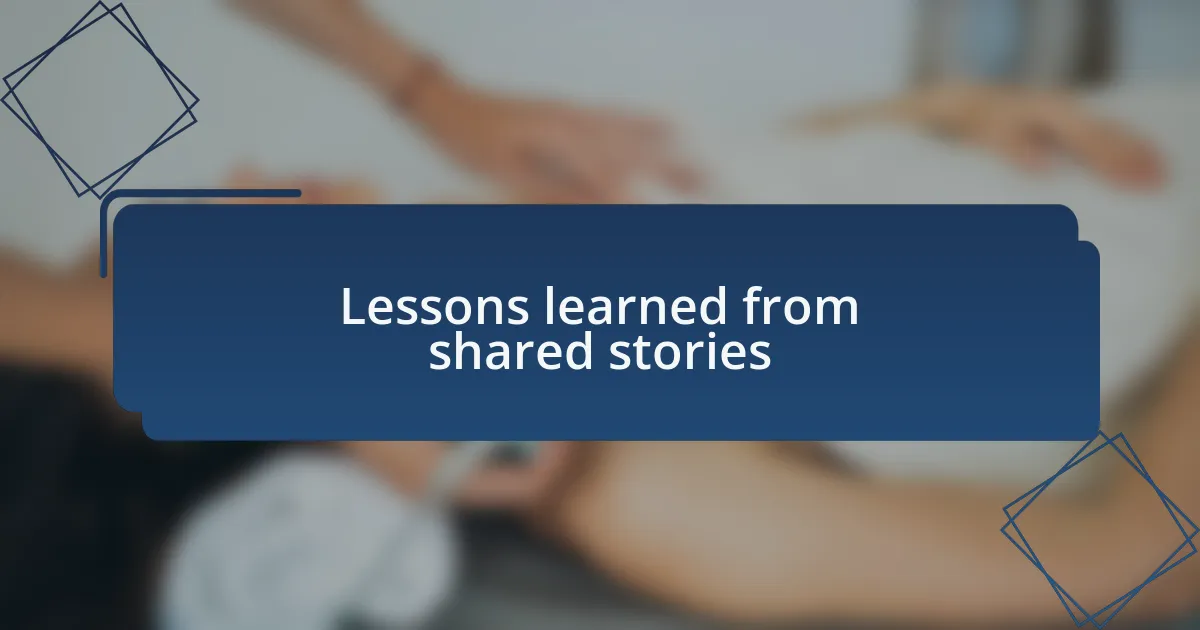
Lessons learned from shared stories
Sharing stories often reveals unexpected lessons that transcend the individual experiences we bring to the group. For instance, during one meeting, we were encouraged to dig deep into the moments that challenged us most. I remember hearing a man speak about his decision to pursue adaptive sports after years of feeling confined by his limitations. His journey ignited thoughts in me—how often do we allow our fears to hold us back from exploring new horizons? Witnessing his triumph transformed my understanding of possibility.
Another profound moment came when we facilitated a storytelling session centered around resilience. Each narrative highlighted different coping mechanisms and strategies used to navigate life’s hurdles. One woman spoke about her daily routine and how she incorporated mindfulness practices to combat stress. It made me reflect on my own habits and encouraged me to adopt similar approaches. Isn’t it interesting how one story can spark a change in perspective for someone else?
In essence, the themes that emerge from our shared experiences are powerful. I recall piecing together insights from multiple sessions, where discussions about self-acceptance surfaced repeatedly. It dawned on me that our collective journey isn’t just about overcoming challenges but celebrating our unique identities. How can we disregard the strength and wisdom found in these narratives? Each meeting reinforced the idea that by sharing, we not only validate our own experiences but also inspire growth in one another.